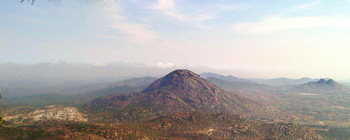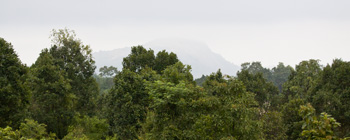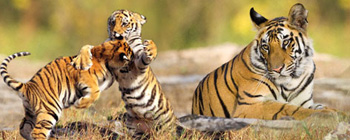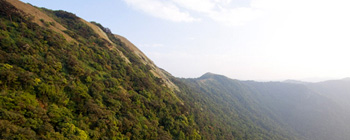Bangalore Birding Hotspots
 Nandi Hills
Nandi Hills
Perhaps the nearest and most easily accessible hills around the city, the Nandi Hills, lie almost due north at a distance of 60 km (45 miles) and are visible from here as a compact block of three rocky outcrops, one of them, Nandidurg, rising some 1416m (4813 feet) above mean sea level. Though most of the original forest cover has disappeared, yielding place to secondary growth, primarily thorny scrub, and the inevitable invasion of the exotic Lantana has occurred together with the 'afforestation' with the Australian Eucalyptus, some percentage of the hill flora has persisted, especially nearer the summit. On this latter is a historical fort, built by native rulers and later captured by Tippu Sultan who lost it to the British forces. Within the limits of this ancient fort, at the present time, is an extensive garden maintained by the Department of Horticulture and an assortment of many exotic trees, shrubs and annuals have been planted amongst the endemic flora. The sides of the hill are clothed with scrub forest mixed with eucalyptus and Lantana almost to two-thirds of the way up and the remaining one-third near the peak, besides the fort garden has more broad-leaved vegetation more typical of the environment. At the base of the hills and surrounding them are more low hills covered with short, thorny scrub along with stands of eucalyptus trees and open cultivation with small 'ravines' and tanks scattered around. There are a small number of the endemic Nilgiri Wood-pigeon that can be seen at Nandi Hills. The rare and highly endemic Yellow-throated Bulbul is also found here. Other species that can be seen here are, Nilgiri Flycatcher, Tickell's Blue Flycatcher, Red-rumped Swallow, Eurasian Blackbird, Pied Thrush, Grey Wagtail, Malabar Whistling Thrush, Grey Junglefowl, Puff-throated Babbler, White-eyed Buzzard, Shikra, Besra, Common Snipe, Blue-faced Malkoha.
 Bannerghatta National Park
Bannerghatta National Park
Bannerghatta National Park is situated 22 km south of Bangalore, Karnataka, India. This hilly place is home to one of the richest natural, zoological reserves.This 104 sq.km national park consists mostly of dense forest and scrub land, and is home to wild animals such as gaur, leopard, wild boar as well as being an important corridor for elephants migrating between the eastern and western ghats. With over 150 species of birds this park is excellent for scrub birding. The park is also home to the endemic yellow-throated bulbul.
 Ranganathittu Bird Sanctuary
Ranganathittu Bird Sanctuary
Ranganathittu Bird Sanctuary is located in the Mandya District of the state of Karnataka in India. It is occupies only 0.67 km². in area, and comprises six islets on the banks of the Kaveri River. Ranganathittu is located near the historic town of Srirangapatna and is very close to the city of Mysore.The islets came into being when a dam across the Kaveri River was built in the 1700s. The famous Indian ornithologist Dr. Salim Ali observed that the isles formed an important nesting ground for birds, and persuaded the Wodeyar kings of Mysore to declare the area a wildlife sanctuary in 1940.
The islands host numerous mammals and migratory birds. Some of them are bonnet macaque, colonies of flying fox and common small mammals like Indian gray mongoose, the monitor lizard and civet. The marsh crocodile also called the mugger crocodile is a common inhabitant of the riverine reed beds. Migratory water birds include Painted Storks, Asian Open bill Storks, Eurasian Spoonbills, Woolly-necked Storks, Black-headed Ibis, White Ibis, Lesser Whistling Duck, Indian Shag, Stork-billed Kingfisher and other birds like egrets, cormorants, oriental darter, and herons. The Great Stone Plover, and River Tern also nest here.
 Nagarhole National Park
Nagarhole National Park
Nagarhole National Park also known as "Rajiv Gandhi National Park", is located 94 kilometers from Mysore in Karnataka in South India. It is spread between Kodagu district and Mysore district. Located to the north-west of Bandipur National Park, the Kabini reservoir separates the two. The park has rich forest cover, small streams, valleys, and waterfalls. The park has a healthy tiger-predator ratio, and tiger, Indian bison, and elephant are much more populous here than in Bandipur. The park stretches over 643 square kilometres. Together with the adjoining Bandipur National Park, Mudumalai National Park and Wayanad Wildlife Sanctuary, it forms the largest protected area in Southern India, totalling 2,183 sq km.
Recognised as an Important Bird Area the park has over 270 species of birds including the 'Critically endangered' Oriental white-backed vulture, 'Vulnerable' lesser adjutant, greater spotted eagle and the Nilgiri wood-pigeon. 'Near threatened' species like darters, oriental white ibis, greater grey headed fish eagle and red headed vulture too can be found here. Endemics include the blue winged parakeet, Malabar grey hornbill and the white bellied treepie. Seven of the 15 Biome-10 (Indian Peninsula Tropical Moist Forest) and 21 of the 59 Biome-11 (Indo-Malayan Tropical Dry Zone) species have been noted from here. Some of the birds that can be sighted here include the white cheeked barbet, Indian scimitar babbler and Malabar whistling thrush. Even birds commonly seen in drier regions like painted bush quail, sirkeer malkoha, ashy prinia, Indian robin, Indian peafowl and yellow-footed green pigeon can be found here.


 Western Ghats Birding - Brahmagiri Wildlife Sanctuary
Western Ghats Birding - Brahmagiri Wildlife Sanctuary